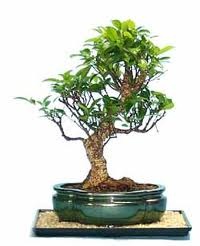 Overview
Overview
Japanese pines work excellently for bonsai. Japanese pine, especially the Japanese black pine, is a sturdy tree that has been known to live for centuries. One notable example, a bonsai that survived the atomic bombing of Hiroshima, is more than 375 years old.
History
The practice of growing miniature trees, called pun-sai, began in China more than 1,000 years ago. Bonsai was introduced to Japan during the Kamakura period (1185 -1333) via Zen Buddhist practices.
Sizes
Bonsai can be grown in several sizes. Miniature bonsai are generally under 2 inches high. Small bonsai are 2-to-6 inches high. Medium bonsai are 6-to-12 inches high, and average bonsai are between 12 and 24 inches high. Larger bonsai are rare and often are older trees, some more than 300 years old.
Styles
Bonsai is grown in several styles: formal upright (chokkan), informal upright (moyogi), slanting (shakan), cascade (kengai), semi-cascade (han-kengai), windswept (fukinagashi) and literati (bunjin).
Significance
Chinese bonsai take their shapes both from tree shapes in nature and from animal forms. Some particularly valuable and rare Chinese bonsai often take the form of a dragon. Japanese bonsai tend to primarily take their shapes from trees in nature.
Time Frame
How long it takes to grow and train a bonsai depends on the type of tree, style and size of bonsai. Trees like Japanese pine take longer to train than other trees. Smaller trees can take from between five and 10 years to train. Larger trees can take as little as three years to grow and train, but often improve with age.

Deprecated: strpos(): Passing null to parameter #1 ($haystack) of type string is deprecated in /home/agriviek8Qv/agriviet.net/public_html/wp-includes/comment-template.php on line 2522